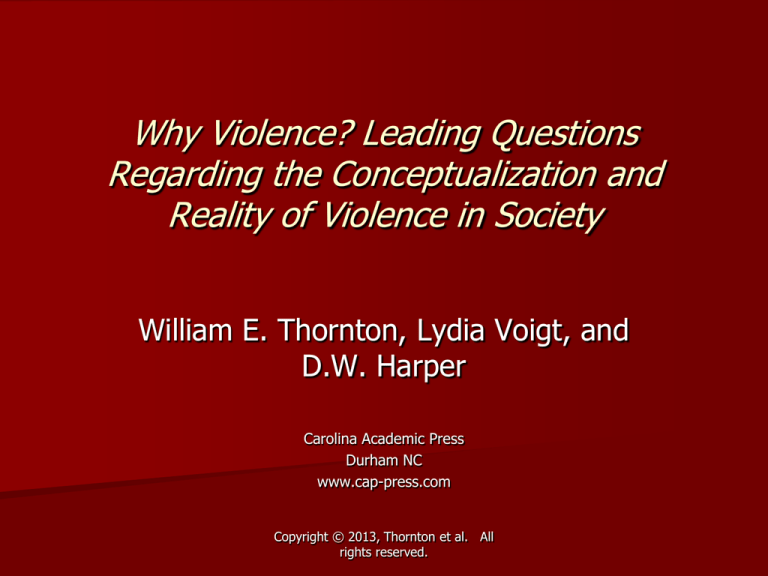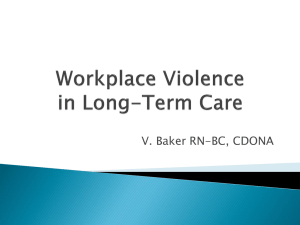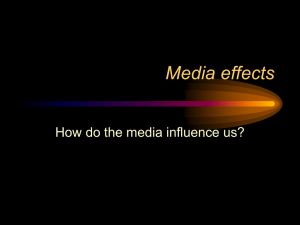
Why Violence? Leading Questions
Regarding the Conceptualization and
Reality of Violence in Society
William E. Thornton, Lydia Voigt, and
D.W. Harper
Carolina Academic Press
Durham NC
www.cap-press.com
Copyright © 2013, Thornton et al. All
rights reserved.
Chapter 1:
What is the Meaning of Violence?
Copyright © 2013, Thornton et al. All
rights reserved.
What is the Meaning of Violence?
Common Definitions
Violence as Physical Force
Violence as Violation
Levels of Violence
-
Interpersonal Violence
- Institutional Violence
- Structural Violence
The Social Construction of Violence in Society
Informal Consensual Realty v. Formal Consensual Reality
Common Stock Knowledge
Cultural Indicators of Violence: Language and Metaphors
Mass Media Images v. the Reality of Violence
Copyright © 2013, Thornton et al. All
rights reserved.
3
Competing Perspectives on Violence
-
Criminal Justice Perspective
- Public Health Perspective
- Human Rights Perspective
- Commercial/Commodity Perspective
The Scientific/Criminological Construction of Violence
Violence and the Law
The Measurement of Violence
Violence Victims
Violence Typologies
The Etiology of Violence
Criminology, the Criminal Justice System, and the Political Order
Debunking Violence Myths
References
Copyright © 2013, Thornton et al. All
rights reserved.
4
What is the Meaning of Violence?
Violence is a conceptual enigma wrapped in a social paradox. Few concepts or
terms are so widely applied, representing such a broad range of meanings and
interpretations, and refer to such a vast spectrum of phenomena.
Violence has countless forms of expression and appears in all social settings
(e.g., homes, workplaces, schools, places of worship, and communities) as
well as across all levels of public and private institutions.
Violence is noted not only for its ubiquity and ambiguity, but also its political
exploitation; e.g., some particular acts of violence may be considered
legitimate and illegitimate at the same time, depending on who is applying the
label and who is being labeled.
For instance, during the war with Iraq, people in the U.S. referred to Iraq’s
military defense arsenal as “weapons of mass destruction” while referring to
their own as “peacekeepers.”
Since the concept of violence lacks concrete specificity and often functions to
emotionally charge and politically define debates or legitimacy of actions, it is
important to approach any discussion or study of violence cautiously.
Copyright © 2013, Thornton et al. All
rights reserved.
5
Common Definitions
Violence as Physical Force
– Most commonly used definition of violence.
– The exercise of physical force so as to inflict injury on, or cause damage to,
persons or property.
– Leaves out many acts of violence, including threats of violence and other nonphysical injury/harm.
– General bias against recognizing nonphysical forms of injury (thus denying
victimization and ultimately justice) has been associated with cases of abuse
such as intimate partner abuse.
Violence as Violation
– Refers to failure to keep or observe or to violate the law.
– Problems exist with this definition.
– Most legal violations are not violent; this is also true of violations of the criminal
code—most criminal offenses are not violent.
– There are many forms of violence that are not part of any legal or criminal code,
including a range of regulatory violations committed by corporations, businesses,
and public officials resulting in public injury and even deaths (e.g., safety
violations, toxic waste dumping, and political corruption and human rights
violations).
Copyright © 2013, Thornton et al. All
rights reserved.
6
Levels of Violence
Determining whether violence is understood as an interpersonal,
institutional, or structural problem is important.
Interpersonal Violence
Interpersonal Violence refers to acts of violence that occur between and
Types of criminal interpersonal violence include homicide, rape, robbery
and assault.
However, other forms of interpersonal violence in varying degrees may be
allowed or tolerated (e.g., parents spanking children, sports violence,
sibling violence).
By focusing chiefly on micro-level or interpersonal forms of violence, public
attention is deflected from other macro-level types of violence (e.g., state
or political forms of violence).
among individuals interacting in a wide range of contexts.
Copyright © 2013, Thornton et al. All
rights reserved.
7
Institutional Violence
Institutional violence refers to acts of violence that emanate in the context of
definitions and patterns of interactions and relationships within the social
milieu of the fundamental institutions of society (such as the family and
familial organizations, schools and educational institutions, workplace and
economic organizations, places of worship and religions organizations, and the
state and the political/legal and public agencies or organizations).
For example, some cases of institutional violence, such as forced intercourse in
the context of a marital union, may not be regarded as a form of criminal rape.
Gross negligence committed by a corporation’s violation of safety rules or
environmental pollution may be handled in civil courts rather than criminal
courts.
Copyright © 2013, Thornton et al. All
rights reserved.
8
In the context of schools, examples may include ignoring abusive treatment
of students by school authorities or failing to offer an adequate education
through discriminatory educational practices.
In the context of the military, acts many range from hazing of recruits to
war crimes such as torture and killing of civilians or non-civilian populations.
In the context of State or political institutions, examples may include human
rights violations by persons in authority or implementation of policies that
work against certain groups by violating their fundamental human rights.
Copyright © 2013, Thornton et al. All
rights reserved.
9
Structural Violence
Structural violence refers to acts of violence that have been accepted as
being necessary for the maintenance of the overall established pattern or
organization of society.
This form of violence is used to protect and reinforce the hierarchical
patterns of society, which determine the power relationships across all
spectrums of society.
The maintenance of structural violence is so important that it is rationalized
and protected both physically (by the military and police) and
psychologically (by dominating political ideology and philosophy).
Structural violence may include violence by either commission or omission
(Iadicola and Shupe, 2003).
Poverty and homelessness in the context of affluent societies such as the
U.S. represent archetypical illustrations of structural violence.
Copyright © 2013, Thornton et al. All
rights reserved.
10
Copyright © 2013, Thornton et al. All
rights reserved.
11
The full set of PowerPoint slides is
available upon adoption.
Email bhall@cap-press.com
for more information.










